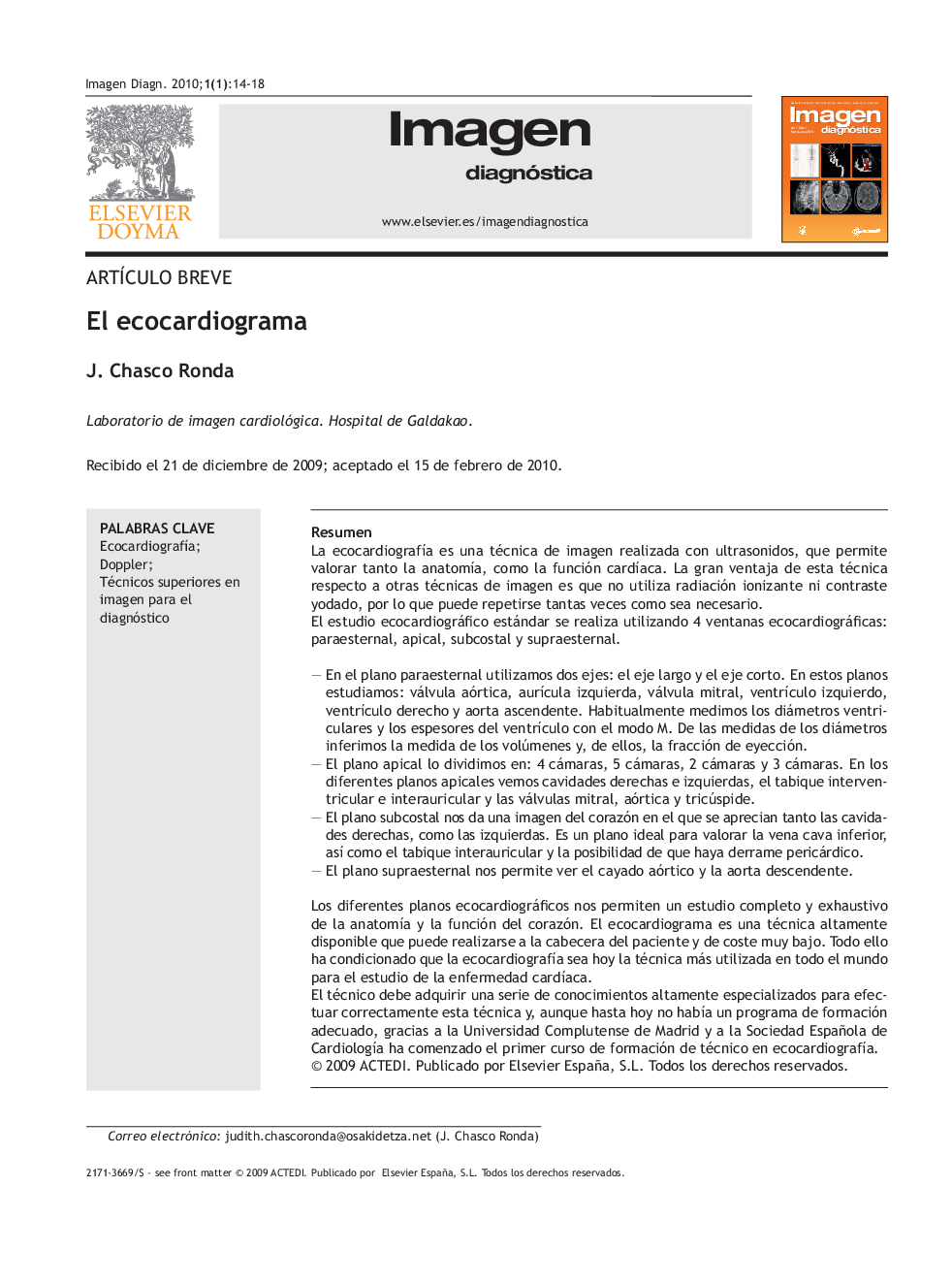| Article ID | Journal | Published Year | Pages | File Type |
|---|---|---|---|---|
| 2736953 | Imagen Diagnóstica | 2010 | 5 Pages |
ResumenLa ecocardiografía es una técnica de imagen realizada con ultrasonidos, que permite valorar tanto la anatomía, como la función cardíaca. La gran ventaja de esta técnica respecto a otras técnicas de imagen es que no utiliza radiación ionizante ni contraste yodado, por lo que puede repetirse tantas veces como sea necesario.El estudio ecocardiográfico estándar se realiza utilizando 4 ventanas ecocardiográficas: paraesternal, apical, subcostal y supraesternal.–En el plano paraesternal utilizamos dos ejes: el eje largo y el eje corto. En estos planos estudiamos: válvula aórtica, aurícula izquierda, válvula mitral, ventrículo izquierdo, ventrículo derecho y aorta ascendente. Habitualmente medimos los diámetros ventriculares y los espesores del ventrículo con el modo M. De las medidas de los diámetros inferimos la medida de los volúmenes y, de ellos, la fracción de eyección.–El plano apical lo dividimos en: 4 cámaras, 5 cámaras, 2 cámaras y 3 cámaras. En los diferentes planos apicales vemos cavidades derechas e izquierdas, el tabique interventricular e interauricular y las válvulas mitral, aórtica y tricúspide.–El plano subcostal nos da una imagen del corazón en el que se aprecian tanto las cavidades derechas, como las izquierdas. Es un plano ideal para valorar la vena cava inferior, así como el tabique interauricular y la posibilidad de que haya derrame pericárdico.–El plano supraesternal nos permite ver el cayado aórtico y la aorta descendente.Los diferentes planos ecocardiográficos nos permiten un estudio completo y exhaustivo de la anatomía y la función del corazón. El ecocardiograma es una técnica altamente disponible que puede realizarse a la cabecera del paciente y de coste muy bajo. Todo ello ha condicionado que la ecocardiografía sea hoy la técnica más utilizada en todo el mundo para el estudio de la enfermedad cardíaca.El técnico debe adquirir una serie de conocimientos altamente especializados para efectuar correctamente esta técnica y, aunque hasta hoy no había un programa de formación adecuado, gracias a la Universidad Complutense de Madrid y a la Sociedad Española de Cardiología ha comenzado el primer curso de formación de técnico en ecocardiografía.
Echocardiography is an ultrasound-based imaging technique that makes it possible to evaluate both the anatomy and function of the heart. The greatest advantage of this technique over others is that it does not use ionizing radiation or iodinated contrast material, so it can be repeated as often as necessary.Standard echocardiographic examination uses four echocardiographic windows: the parasternal, apical, subcostal, and suprasternal.–In the parasternal plane, images are obtained along two axes: the long axis and the short axis. These views enable the aortic valve, left atrium, mitral valve, left ventricle, right ventricle, and ascending aorta to be studied. The M mode is normally used to measure the ventricular diameters and thickness. Volumes are determined from the diameters measured, and the ejection fraction is inferred from the volumes.–The apical plane is divided into four views showing four chambers, five chambers, two chambers, and three chambers. The different apical views show the right and left cavities, the interventricular and interatrial septa, and the mitral, aortic, and tricuspid valves.–The subcostal plane provides an image of the heart in which both the left and right chambers of the heart can be seen. It is the ideal plane for assessing the inferior vena cava as well as the interatrial septum and for determining whether there is pericardial effusion.–The suprasternal plane makes it possible to see the aortic arch and the descending aorta.The different echocardiographic planes enable a complete and thorough examination of the anatomy and function of the heart. Because echocardiography is widely available, very economical, and can be performed at the patient's bedside, it is the most widely used technique in the study of heart disease around the world.To carry out this technique correctly, technicians need to acquire a body of specialized knowledge. Until very recently, no programs to train technicians in this technique were offered in Spain; however, the Complutense University of Madrid and the Spanish Society of Cardiology have just started the first course to train technicians to perform echocardiography.
